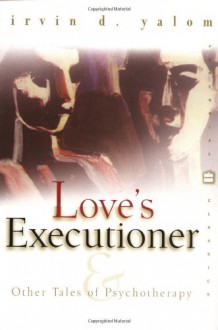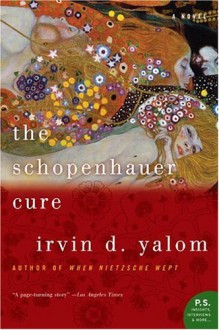
Irvin Yalom: A Fumbling Therapist?
“Though there is something reassuring about the omniscient therapist who is always in control of every situation, there can be something powerfully engaging about a fumbling therapist, a therapist willing to flounder with the patient until they, together, stumble upon an enabling discovery.” (p36)This book is a collection of ten case studies by a psychiatrist who is also a university professor. It certainly contains a lot of advice for other therapists, much of it humbling. It possibly gives guidance to people considering seeking therapy, or at any rate feeling in need of support at a time of personal distress. In principle, it is also an exercise in philosophy, since the deeper questions confronted in therapy turn out to coincide with those posed through philosophy.
“I have found that four givens are particularly relevant to psychotherapy: the inevitability of death for each of us and for those we love; the freedom to make our lives as we will; our ultimate aloneness and, finally, the absence of any obvious meaning or sense to life.” (p4) “So Marvin and I had reached a crucial point, a juncture to which full awareness inevitably leads. It is the time when one stands before the abyss and decides how to face the pitiless existential facts of life: death, isolation, groundlessness and meaninglessness. Of course, there are no solutions. One has a choice only of certain stances: to be “resolute,” or “engaged,” or courageously defiant, or stoically accepting, or to relinquish rationality and, in awe and mystery, place one’s trust in the providence of the Divine.” (p260) It is clear enough from the preceding quote where Yalom stands in regard to religion as a possible answer to these basic questions, but at another point in the book he makes equally clear that he is not inclined to challenge religious belief in his patients:
“But there is timing and judgement. Never take away anything if you have nothing better to offer. Beware of stripping a patient who can’t bear the chill of reality. And don’t exhaust yourself by jousting with religious magic: you’re no match for it. The thirst for religion is too strong, its roots too deep, its cultural reinforcement too powerful” (p154) Indeed Yalom is not keen for a therapist to be seen as imposing their own opinions, beliefs or solutions on any patient: he runs a mile from the status of guru or master or shaman.
”I’ve always believed it’s as important to find out what makes one better as it is to determine what makes one worse, so I asked her what makes the difference.
“Somehow” Marge said, “our last hour turned things around. It is almost miraculous how you, in such a short time, pulled me out of that funk. I’m really glad you’re my psychiatrist.”
Though charmed by her ingenuous compliment, I was made uncomfortable by both thoughts: the mysterious ‘somehow’ and the vision of me as a miracle worker. As long as Marge thought on those terms, she would not get better because the source of help was either outside of herself or beyond comprehension. My task as a therapist (not unlike that of a parent) is to make myself obsolete - to help a patient become his or her own mother and father. I didn’t want to make her better. I wanted to help her take the responsibility of making herself better, and I wanted the process of improvement to be as clear to her as possible…” (p219) ”The project of psychiatric “treatment” is fraught with internal inconsistencies. When one person, the therapist, “treats” another, the patient, it is understood from the beginning that the treatment pair, the two who have formed a therapeutic alliance, are not equals or full allies: one is distressed and often bewildered, while the other is expected to use professional skills to disentangle and examine objectively issues that lie behind the distress and bewilderment. Furthermore, the patient pays the one who treats. The very word treat implies non-equality. To “treat” someone as equal implies an inequality which the therapist must overcome or conceal by behaving as though the other were an equal. … Perhaps it is more accurate to describe therapy as treating the patient as an adult. This may seem like scholastic hair splitting, yet [I had] to be very clear about how I wanted to relate to her or, for that matter, to any other patient.” (p221) Indeed, Yalom makes clear on a number of occasions that it is bad practice and very unskillful for a therapist to impose their own interests or priorities on a patient:
“Yet I am not without faith, my Hail Mary being the Socratic incantation, “The unexamined life is not worth living.” But that was not Dave’s faith. So I curbed my curiosity.” (p154) We can all spot when people are clinging to a delusion. The therapist’s task is to discover what role that plays in helping people to get by. It is unskillful to puncture people’s illusions without first putting in place an alternative. Thelma’s therapy comes to a crashing halt when Yalom makes that error.
”I got little solace … from lamenting the weakness of the human spirit - that feeble wraith unable to survive without illusion, without enchantment or pipe dreams.” (p65) Nor does he make excessive claims for his own potency as a therapist.
“How comforting it would be to feel, just once, that I know exactly what I’m doing in my psychotherapeutic work - for example, that I am dutifully traversing, in proper sequence, the precise stages of the therapeutic process. But of course, it is an illusion. ...ideological schools with their complex metaphysical edifices succeed because they assuage the therapist’s, not the patient’s, anxiety… The more the therapist is able to tolerate the anxiety of not knowing, the less need is there for the therapist to embrace orthodoxy. The creative members of an orthodoxy, any orthodoxy, ultimately outgrow their disciplines.” (36)Many therapists from different disciplines will make a similar comment, to the effect that they do not allow their training or their discipline, the tribe to which they belong through their training, to take the form of an ideology, demanding that their patient / client conform to the categories and labels of their theoretical models. Therapy is more pragmatic than that. This is a valuable reassurance, because it is well known that there are some therapists (certainly some published theorists) who have been very ideological in their approaches, determined to fit inconvenient evidence into their prescribed compartments. But the ten case studies reported here demonstrate repeatedly how Yalom relies on a repertoire of techniques and skills arrived at through his training and, on occasion, he even mentions the name of the trainer from whom his ideas were taken. So he is not to be understood as saying that all this theory and training does not matter or can be disregarded.
One paragraph struck me as a possible quick guide to the sources of Yalom’s approach:
“As this material unfolded, it was possible to understand Marvin’s current problems from each of three very different perspectives: the existential (with a focus on the ontological anxiety that had been evoked by passing a major life milestone); the Freudian (with an emphasis on oedipal anxiety); and the communicational (with an emphasis on how the marital equilibrium had been unsettled by recent life events. …)” (p253) Yalom certainly does apply theory to help interpret the stories brought to therapy by his patients. It becomes apparent, though, that these interpretations, which have a great impact on his own experience as a therapist, are frequently if not invariably far less significant to his patients. This comes out in his striking case study entitled “Two Smiles.” He has an opportunity to observe an interaction between a hypnotherapist and a patient, in which two separate incidents arise marked by a smile, and are not only noticed but also considered highly significant by all three parties - the observer, the patient, the hypnotherapist. However, while they all experienced the same incidents, they had dramatically different and totally unrelated meanings for each of the three, so that they might just as will have been in different places doing different things. The belief that they shared an experience was, in truth, something of an illusion. If that is the case for this simple social interaction, how much more true must it be of an extended relationship or even a whole lifetime of seemingly shared experiences within a family?
What is going on between a patient and therapist is something that Yalom shows great commitment to revealing, even though that leads to much self deprecation. If the private experiences - the thoughts and feelings - of his patients are really inaccessible to him, and if the source of their suffering is no less opaque to them, then how is he to help his patients to bring them into the open for scrutiny and hopefully change?
Yalom puts a lot of weight on the Freudian concept of counter-transference. As I understand it, the point is that I cannot directly read your mind nor directly feel what you feel, but what I can learn to do is to observe my own thoughts and feelings with severe honesty. The way I respond to you gives some clues to what you are communicating to me. By monitoring my internal responses, I catch a glimpse of what might be in your mind. Yalom is prepared to be pretty brutal towards himself, savagely tackling the internal activities of his own mind that obstruct any aspect of his work with a patient. If he is bored, for example, then he examines that boredom and looks for its source, because that is significant.
The same applies to other types of response. Betty (the "Fat Lady") knew from the first meeting that Yalom found her obesity hideous. His inability to acknowledge this was not helpful and his attempt to hide it a complete failure. He appreciates too late that there could have been many benefits from addressing his attitudes and his reaction to the obesity of his patient. His inability to handle his own feelings interfered with his work as her therapist.
Another concept that is pivotal for Yalom is this:
It’s the relationship that heals, the relationship that heals, the relationship that heals - my professional rosary. (p91) ”Whenever the patient develops symptoms in respect to the relationship with the therapist, therapy has really begun and inquiry into these symptoms will open the path to the central issues.” (p99) Whenever the content of a therapy session becomes challenging, Yalom describes how he turns his attention to what he calls “process,” which for him means the way in which the relationship of patient and therapist is playing out in the room. His earliest task is to form a working relationship with each new patient and whenever he feels that this is weakening, he turns away from all other issues and concentrates on restoring that working relationship without which therapy cannot proceed.
“But over the years I’ve learned that the therapist’s venture is not to engage the patient in a joint archaeological dig. If any patients have ever been helped in that fashion, it wasn’t because of the search …. No, a therapist helps a patient not by sifting through the past by by being lovingly present with that person; by being trustworthy, interested; and by believing that their joint activity will ultimately be redemptive and healing. The drama of age regression and incest recapitulation (or, for that matter, any therapeutic cathartic or intellectual project) is healing only because it provides therapist and patient with some interesting shared activity while the real therapeutic force - the relationship - is ripening on the tree.” (227) In the end, psychotherapy is a talking cure an Yalom has great confidence in the value of conversation. A technique he describes using quite often is simply to ask for as much information as possible:
“Details are wonderful. They are informative, they are calming, and they penetrate the anxiety of isolation: the patient feels that, once you have the details, you have entered into his life.” (p188) Not surprisingly, the ten case studies are all successful. Yalom’s first example concerns a woman in her seventies, his second a man with terminal cancer, and in these cases as throughout the book, he seeks evidence that therapy can be beneficial. He refers to his involvement in formal research to establish evidence of the outcomes achieved, but remarks at one point that it is hard for such studies to expose the type of positive experience that is, for him, the most convincing evidence. The best evidence is qualitative, rather than quantitative, and can surely be glimpsed in these case studies, to the extent that they are credible, as I think they are.
”At times, Betty expressed anger at my forcing her to think about morbid topics. “Why think about death? We can’t do anything about it.” I tried to help her to understand that, though the fact of death destroys us, the idea of death can save us. In other words, our awareness of death can throw a different perspective on life and incite us to rearrange our priorities. Carlos had understood that lesson - it was what he meant on his deathbed when he talked about his life having been saved.” (p111)
 Listened to this audiobook prior to starting a degree in counseling. I don't think I have enough of a professional perspective to have a personal opinion on the quality of this advice, but it was helpful in terms of giving me the opportunity to think about therapy as a prospective therapist, rather than a client. Not sure what to make of Yalom, not being familiar with him from his other writing - but I really disliked the narrator for this audiobook & it's hard to differentiate two. I was not at all expecting to find so much philosophy in this book, for some reason. It was a sweet surprise to hear about my fav Spinoza at the end of this book.
Listened to this audiobook prior to starting a degree in counseling. I don't think I have enough of a professional perspective to have a personal opinion on the quality of this advice, but it was helpful in terms of giving me the opportunity to think about therapy as a prospective therapist, rather than a client. Not sure what to make of Yalom, not being familiar with him from his other writing - but I really disliked the narrator for this audiobook & it's hard to differentiate two. I was not at all expecting to find so much philosophy in this book, for some reason. It was a sweet surprise to hear about my fav Spinoza at the end of this book.

 Log in with Facebook
Log in with Facebook 









